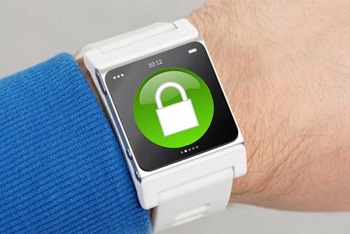As the number of smartwatch and smartband wearers grows, the amount of data tracking increases, too.
According to the results of a recent mobile security study that have just been published, the users of wearable tech devices can become the victims of cyber attacks, personal data breaches, or simply basic tracking by an individual with a low budget and a small amount of knowledge on the subject.
In fact, the study showed that all that is required is about $70 worth of hardware to track a wearable tech user.
The study was conducted by Symantec, the online and mobile security giant. Its researchers came up with a very simple design that brought a Bluetooth radio module together with a Raspberry Pi computer that was capable of scanning the area for the signals of wearable technology. The device was brought to various parks and sporting events where the researchers were then capable of recording the data that was being broadcasted by devices that were nearby.
The mobile security “attack” went completely undetected by the device users because no attempt was made to connect.
 The device made by the researchers never attempted to make a connection with the specific wearables that were being tracked. This was not required because the data was collectable due to the sheer simplicity of the wearable tech, which communicates with more complex devices – such as smartphones, tablets, and laptops – in order to make its information usable to the wearer.
The device made by the researchers never attempted to make a connection with the specific wearables that were being tracked. This was not required because the data was collectable due to the sheer simplicity of the wearable tech, which communicates with more complex devices – such as smartphones, tablets, and laptops – in order to make its information usable to the wearer.
The researchers brought the detection devices to public places in Ireland and Switzerland. They found that among all the types of mobile devices that are carried by people in these types of location, it was wearables that were particularly easy to track. According to the team, in a blog post that they made on the subject, “All the devices we encountered can be easily tracked using the unique hardware address they transmit.”
Among the types of mobile security vulnerability that were found in these devices, the researchers were also capable of remotely probing the gadgets to reveal identifying information or serial numbers. That said, they felt that this type of information would be considered to be “trivial” by people who have computer knowledge and who would be capable of actually accessing this data.
As though swipe cards and security cameras weren’t enough, some say that wearables will be the next step.
As wearable technology starts to flood the tech market in virtually every shape and form, from Google Glass to Samsung Gear and Pebble, there are now predictions being released to suggest that these devices will soon be used as the next level of employee tracking.
These wearable devices will give employers the chance to track workers in an effort to improve worker productivity.
At the same time, it is very likely that this will be quite a controversial use for wearable technology, as this will make some workers feel that this level of tracking will cut into their personal privacy. That said, it cannot be denied that it does present employers with an opportunity to gain a better understanding of how things are done and how they can be improved so that the job will be completed with greater efficiency.
Wearable technology could allow data to be collected in order to give employees the ability to work smarter.
 According to a workplace management company called Kronos, it is already creating products for retailers and manufacturers that have communication and tracking capabilities and that will be available for use before the close of 2014. When combined with this type of solution, wearables could come with the potential for considerable productivity and safety benefits, according to the Kronos vice president of global product management, Bill Bartow.
According to a workplace management company called Kronos, it is already creating products for retailers and manufacturers that have communication and tracking capabilities and that will be available for use before the close of 2014. When combined with this type of solution, wearables could come with the potential for considerable productivity and safety benefits, according to the Kronos vice president of global product management, Bill Bartow.
He provided the example that nurses could wear a sensor on their clothing that detects the individual’s heart rate. This would allow them to become more aware of their physical state so that long shifts would lead to a lower level of fatigue. Another example is in the case of manufacturing companies, which frequently ban the use of cell phones on the job. Instead, wristbands or smartwatches that include GPS or geolocation technology could be worn by the employees in order to remind them to return back to the job when they have over-extended their smoke breaks, said Bartow.
He went on to explain that with this type of wearable technology, “The manager could know their location and communicate with them through that device through an alert or a notification and say: ‘We need you immediately.’” In this, it seems that the tech will likely be far more popular among the employers than the employees.
 The device made by the researchers never attempted to make a connection with the specific wearables that were being tracked. This was not required because the data was collectable due to the sheer simplicity of the wearable tech, which communicates with more complex devices – such as smartphones, tablets, and laptops – in order to make its information usable to the wearer.
The device made by the researchers never attempted to make a connection with the specific wearables that were being tracked. This was not required because the data was collectable due to the sheer simplicity of the wearable tech, which communicates with more complex devices – such as smartphones, tablets, and laptops – in order to make its information usable to the wearer.
 According to a workplace management company called Kronos, it is already creating products for retailers and manufacturers that have communication and tracking capabilities and that will be available for use before the close of 2014. When combined with this type of solution, wearables could come with the potential for considerable productivity and safety benefits, according to the Kronos vice president of global product management, Bill Bartow.
According to a workplace management company called Kronos, it is already creating products for retailers and manufacturers that have communication and tracking capabilities and that will be available for use before the close of 2014. When combined with this type of solution, wearables could come with the potential for considerable productivity and safety benefits, according to the Kronos vice president of global product management, Bill Bartow.